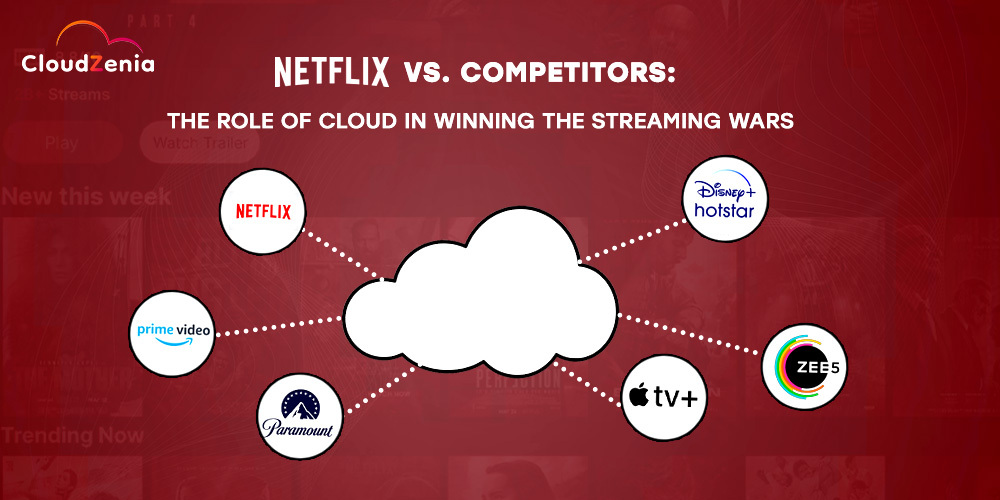
It is well known that the broader media and entertainment sector has faced significant difficulties in recent years. These challenges have been weighed down by labour disputes, issues in profitability, and a shift towards streaming that has disrupted some of the most recognised corporate giants.
However, one company has flourished amidst these modifications: Netflix (NFLX).
The streaming service surpassed Wall Street’s expectations across all major financial metrics in its third-quarter results released on 17 October 2024. Its shares soared to unprecedented highs. The stock has risen by over 50 percent since the year’s beginning.
Netflix is evidently sprinting ahead, while Netflix competitors (the very media-focused streaming firms) are finding it challenging to even step onto the playing field.
The company’s transition to the cloud, exemplified by Netflix using AWS, resulted in a surge in customer loyalty. The company has successfully built a brand that rivals are still striving fiercely to surpass in the video streaming market.
Netflix exemplifies a remarkable case study in digital transformation. They revolutionised their entire business model and ventured into uncharted territory.
The Streaming Landscape

Streaming services started gaining traction in the early 2000s. However, it was Netflix that revolutionised the sector by transitioning from DVD rentals to streaming in 2007. This daring step ushered in a transformative era of content consumption. As Netflix flourished, competitors emerged, each with distinct offerings. Amazon Prime Video, Disney+ Hotstar, and others have entered the fray. Each is vying to capture a share of the growing subscriber base.
Cloud technology has become a cornerstone of the streaming industry. It puts forth platforms with the ability to store vast amounts of content and deliver it seamlessly to users worldwide. The benefits of cloud infrastructure include scalability to handle millions of simultaneous viewers and reliability to maintain service quality. It also offers cost-effectiveness that allows for competitive pricing.
Netflix’s Cloud Strategy

Netflix was a trailblazer in the transition from physical media to digital streaming. The achievements can be credited to the advanced Netflix cloud architecture. Netflix using AWS effortlessly provides high-quality content to millions of viewers globally. This cloud-centric strategy facilitates:
– Leveraging Amazon Web Services (AWS)
Netflix’s strategy is built around its collaboration with Amazon Web Services. By using AWS’s strong infrastructure, Netflix can grow its services worldwide, providing high-quality streaming to millions of viewers. The Netflix AWS architecture allows the platform to store its content across numerous data centres. This setup reduces latency and ensures that users encounter minimal buffering, regardless of their location. This strategic decision enhances Netflix’s dependability, a vital element in retaining subscribers, especially when considering the ongoing discussions surrounding Amazon Prime vs Netflix in streaming wars.
– Data Analytics and User Personalisation
Netflix has perfected the art of data analytics. This employs it to customise the viewing experience according to individual preferences. By gathering and examining user behaviour data—such as ratings, viewing history, and search patterns—Netflix is able to produce personalised recommendations that keep viewers engaged. This data-driven methodology aids in content discovery and shapes Netflix’s content creation strategy. The streaming giant invests significantly in original programming that resonates with user preferences. This leads to higher retention rates and ultimately boosts subscriber growth.
– Microservices Architecture
Another crucial element of Netflix cloud services architecture is its microservices infrastructure. This methodology divides the platform into small, independent services that can be developed, deployed, as well as, scaled on their own. This modular design enhances the platform’s resilience. This enables Netflix to rapidly update or address specific components without needing to take the entire service offline. This flexibility is vital for maintaining a seamless user experience and adapting to changing market demands. This showcases the effectiveness of Netflix tech in action.
Netflix Competitors’ Cloud Strategies
Netflix’s strategic commitment to AWS cloud technology has been a crucial element in its ascent to the forefront of the streaming wars. By utilising a strong infrastructure and enhancing user experience, Netflix has surpassed its rivals. This has established a high benchmark in content delivery and dependability that others aim to emulate.
– Amazon Prime Video
Amazon Prime Video operates on a hybrid cloud model. It utilises both, its own infrastructure and third-party services. While this provides Amazon with some flexibility, it often leads to a less consistent user experience when compared to Netflix. In the Prime vs Netflix debate, Amazon Prime Video boasts a vast library of content.
However, its interface can be somewhat cluttered. This makes it difficult for users to discover new shows. Furthermore, although Amazon invests in original content, it frequently lacks the same level of data-driven personalisation that Netflix offers, which is a significant factor in the Amazon Prime vs Netflix comparison.
– Disney+ Hotstar
Disney+ Hotstar adopts a distinctive approach by leveraging its vast library of cherished franchises, such as Star Wars and Marvel. The platform employs cloud technology to deliver localised content tailored to regional markets, especially in India, where it has gained considerable popularity.
By providing content in various languages and catering to local preferences, Disney+ Hotstar competes effectively with Netflix in diverse markets. However, its cloud strategy is still developing. It must continue to improve its infrastructure to rival Netflix’s reliability, a key consideration in the Hotstar vs Netflix comparison.
Wrapping Up
In the ever-changing streaming services world, Netflix’s groundbreaking cloud setup has strengthened its position as an industry leader. By using advanced technology and data analysis, Netflix enhances user experience and sets the standard for content delivery and reliability. While competitors like Amazon Prime Video and Disney + Hotstar work hard to keep up, the challenges they face show how important cloud systems are for success. The ongoing talks about Amazon Prime vs Netflix and Hotstar vs Netflix highlight these struggles.
For those keen to delve deeper into Netflix AWS architecture, cloud computing, and its transformative effects, visit CloudZenia blogs for expert perspectives and knowledge on cloud and Netflix technology.

